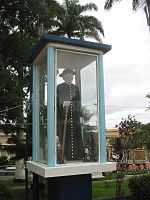Padre Cícero
| Cícero Romão Batista | |
|---|---|
 Padre Cícero at the age of 80. | |
| Religion | Catholicism |
| Other names | Padim Ciço |
| Personal | |
| Nationality |
|
| Born |
March 24, 1844 Vila Real do Crato, Ceará |
| Died |
July 20, 1934 (aged 90) Juazeiro do Norte, Ceará |
| Resting place |
Capela do Socorro in Juazeiro do Norte 07°12′46″S 39°18′54″W / 7.21278°S 39.31500°W |
| Senior posting | |
| Based in | Juazeiro do Norte, Ceará, Brazil |
| Title | Catholic priest |
| Period in office | 1870 to his death (he was excommunicated in 1917 and defrocked in 1921) |
| Religious career | |
| Ordination | November 30, 1870 |
Padre Cícero (Crato, March 24, 1844 - Juazeiro do Norte, July 20, 1934) was born Cícero Romão Batista in Ceará, Brazil. He was the son of Joaquim Romão Batista and Joaquina Vicência Romana. When he was 6 years old, he started to study with professor Rufino de Alcântara Montezuma.
One important thing about his infancy is his pledge of chastity, made when he was twelve. This was influenced by him reading about the life of Saint Francis de Sales.
In 1860, he went to school in Cajazeiras, but because of the untimely death of his father, he had to return home to his mother and sisters in 1862. The death of his father, who was a small businessman in Crato, brought serious financial difficulties to his family.
Ordination
Padre Cícero was ordained on November 30, 1870. After his ordination he returned to Crato and taught Latin in the Colégio Padre Ibiapina, founded and directed by professor José Joaquim Teles Marrocos his cousin, and friend.
Relocation

Christmas of 1871, invited by his teacher Simeão Correia de Macedo, Padre Cícero visited for the first time the small community of Juazeiro (which at the time was part of Crato) and celebrated the traditional "missa do galo".
The visiting padre who was 28 years old, short, white-skinned, light haired, and who had penetrating blue eyes, impressed the locals. And he was impressed by them. So after a few months, exactly on 11 April 1872, he was back with his family and suitcases, to stay there as a permanent resident in Juazeiro.
Many books state that Padre Cícero decided to stay in Juazeiro because of a dream or vision that he had. This supposed dream occurred after a long day of hearing confessions, when he looked for a room to rest in and fell asleep. According to his close friends, he saw Jesus Christ, and the twelve apostles sitting at a table, similar to Leonardo da Vinci's "Last Supper". Suddenly, the place was full of poor North Eastern Brazilians. Christ, looking to the poor, said that he was upset with humanity, but that he was still willing to do the last sacrifice to save the world. But, if men didn't repent quickly, He was destroy everything at once. At that moment, he pointed to the poor and, said, "And you, Padre Cícero, take care of them!"
Apostleship

Padre Cícero initially started work on the small local chapel, getting different images with the offerings of the faithful.
After, touched by the burning desire to win over the people that God confided into his care, he started intense preaching. He gave many counsels, and made many visits to homes, starting to exercise great leadership in the community. Also, he began to try to change the immoral customs of the people, personally getting rid of excessive drunkenness and prostitution.
With harmony restored, the community started to grow. Many people from neighboring communities were attracted by the new large chapel.
Today
Today, a large statue of Padre Cícero stands in Juazeiro do Norte. A pilgrimage to this statue takes place in his honour every November, attracting hundreds of thousands of followers.
Padre Cícero was posthumously canonized by the Brazilian Catholic Apostolic Church, a dissident religious organization.
External links
- http://www.sfiec.org.br/noticias/padrecicero260704.htm
- http://www.cruzterrasanta.com.br/padre-cicero/#historia
- http://www.padrecicero.org.br/
|